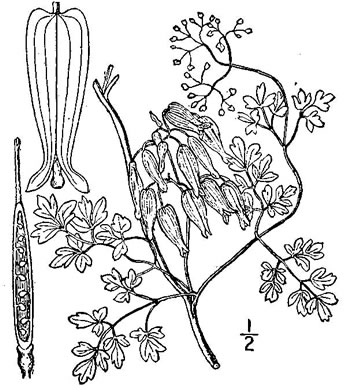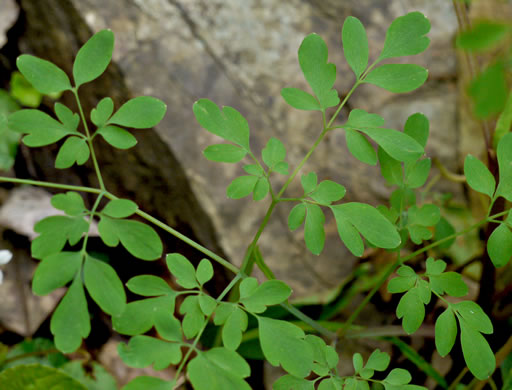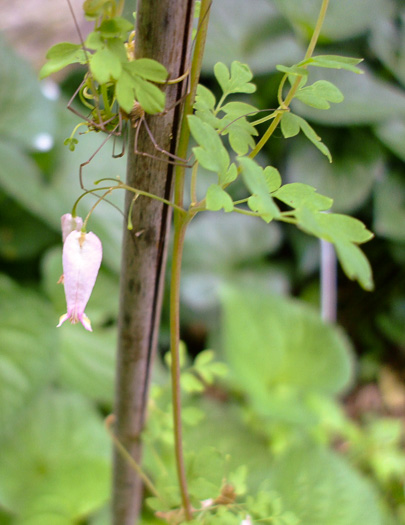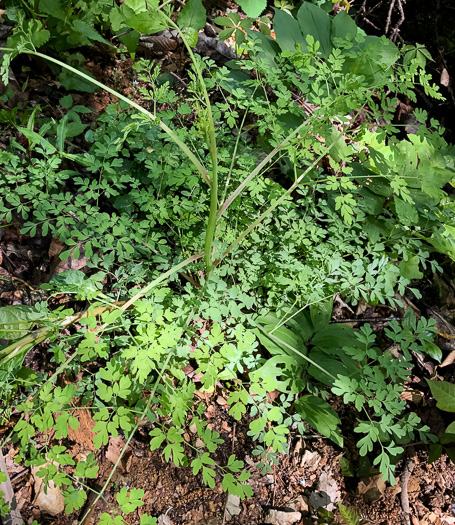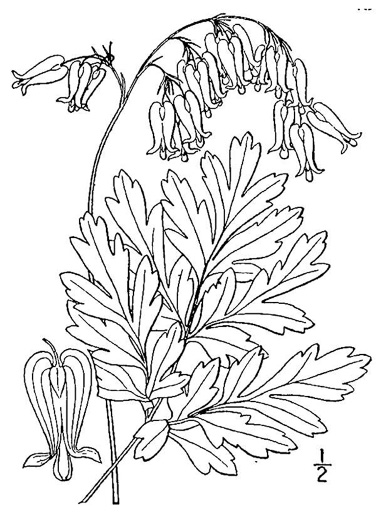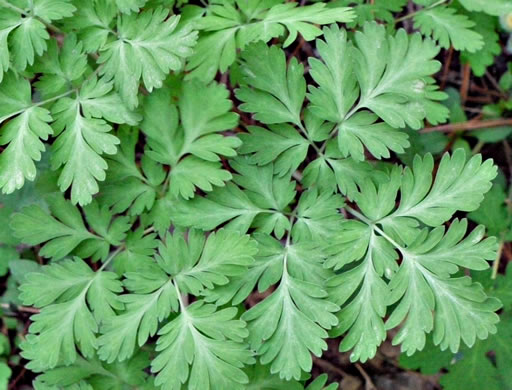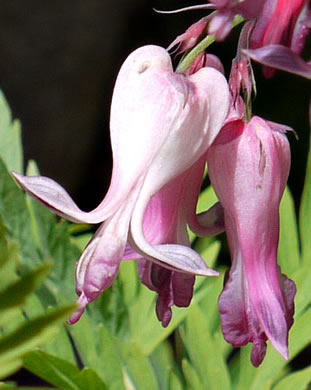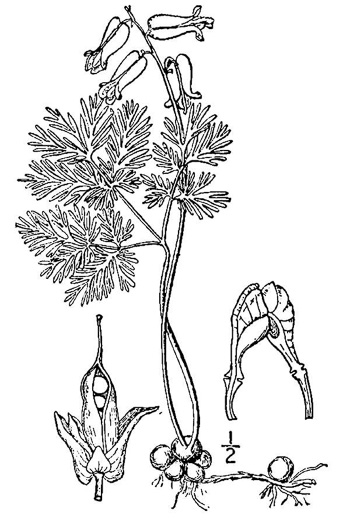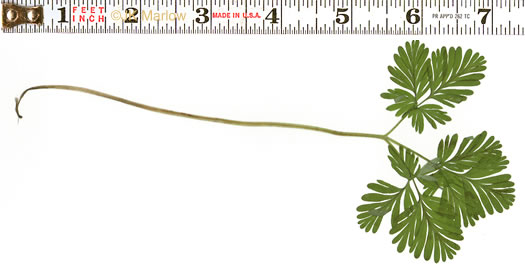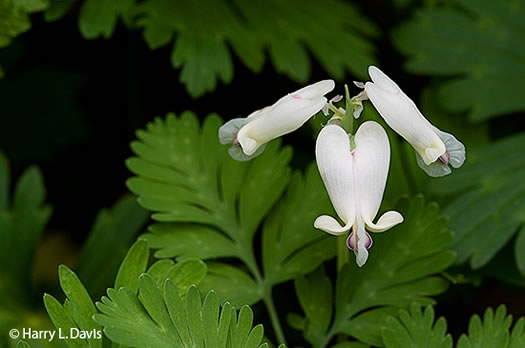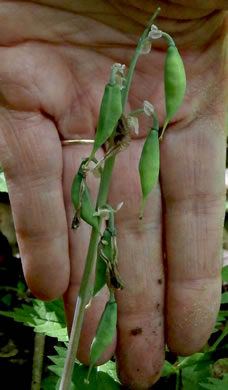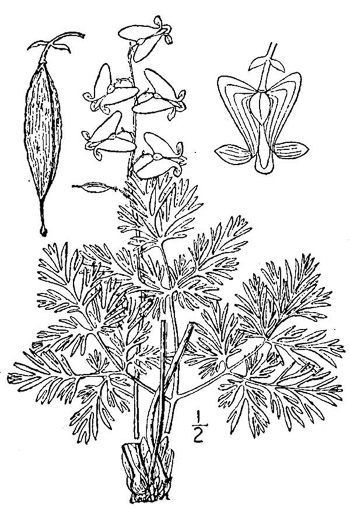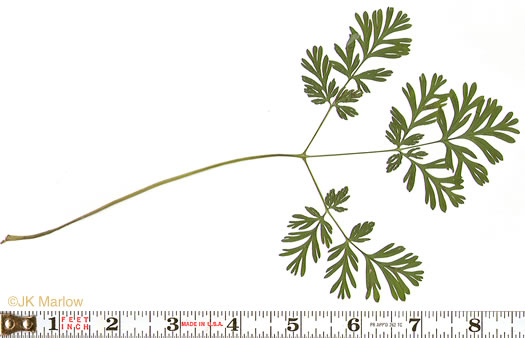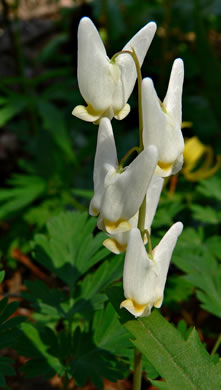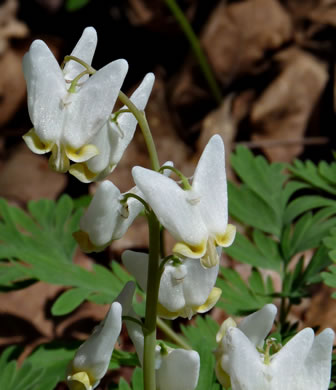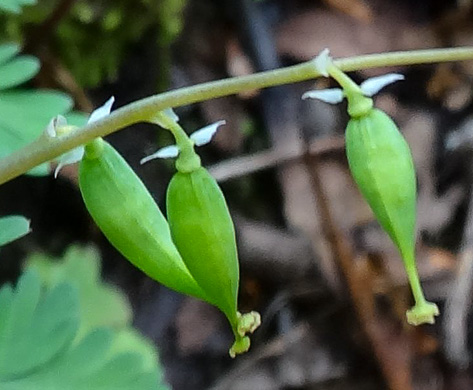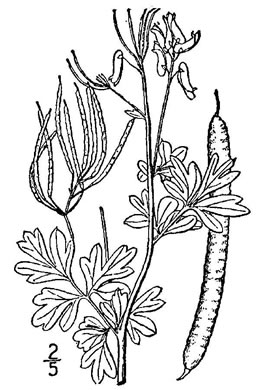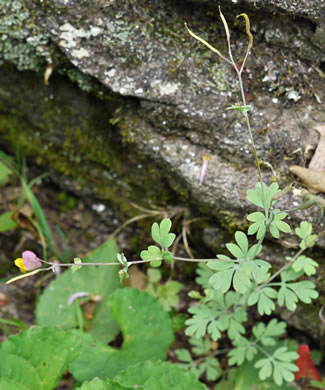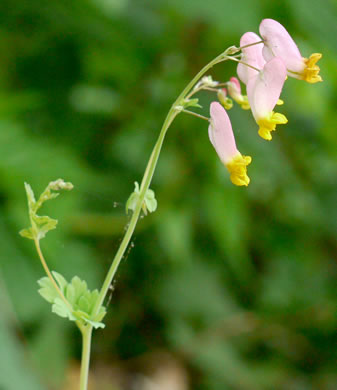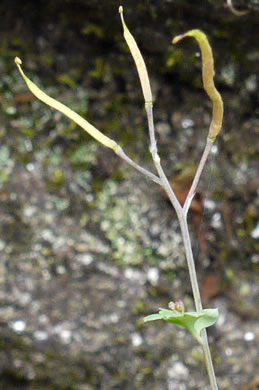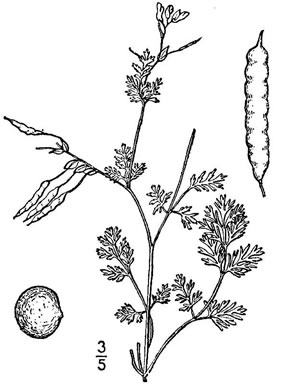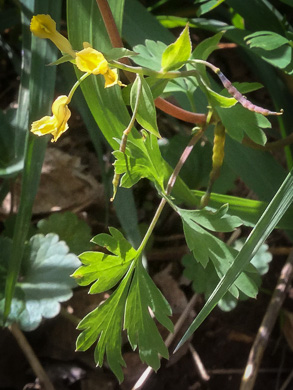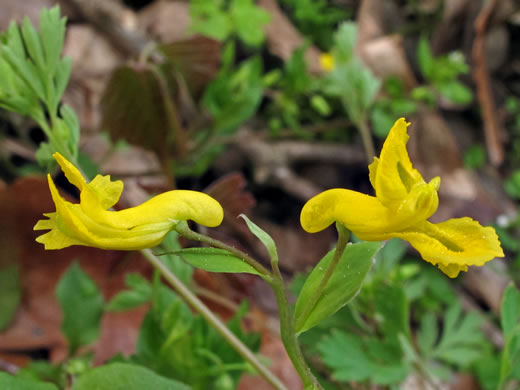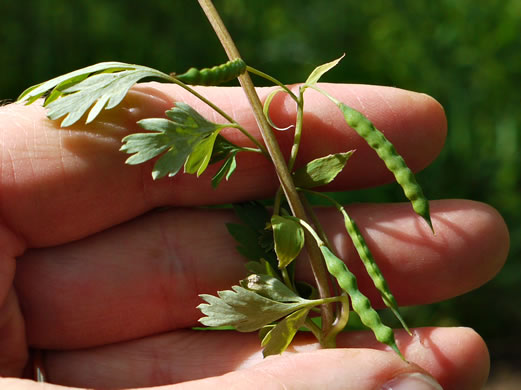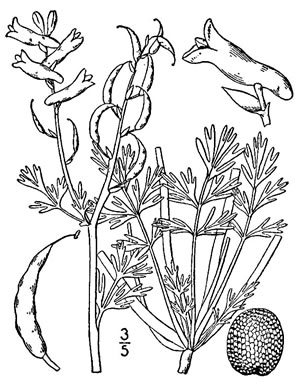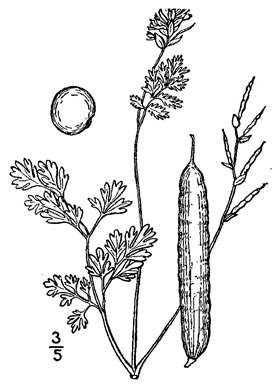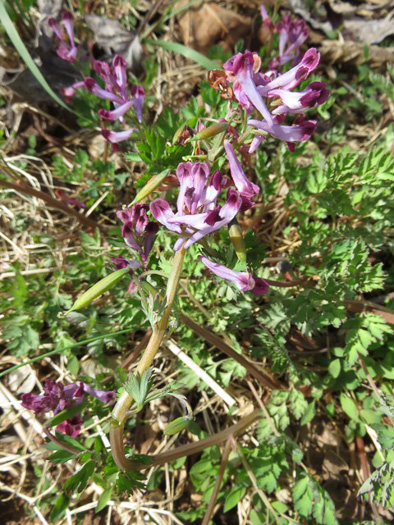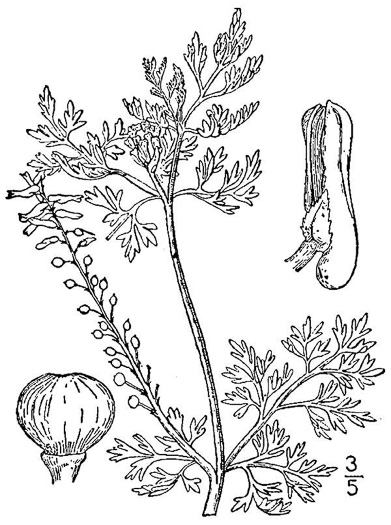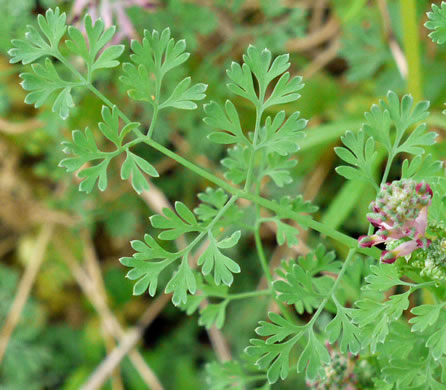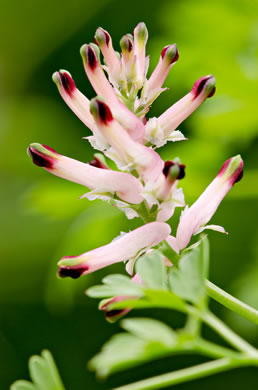Hovering over an image will enlarge it and point out features (works better on desktop than on mobile).
![]() A camera indicates there are pictures.
A camera indicates there are pictures.
![]() A speaker indicates that a botanical name is pronounced.
A speaker indicates that a botanical name is pronounced.
![]() A plus sign after a Latin name indicates that the species is further divided into varieties or subspecies.
A plus sign after a Latin name indicates that the species is further divided into varieties or subspecies.
Most habitat and range descriptions were obtained from Weakley's Flora.
Your search found 10 taxa in the family Fumariaceae, Fumitory family, as understood by Weakley's Flora.

![]() Common Name:
Climbing Fumitory, Allegheny Vine, Cliff-Harlequin
Common Name:
Climbing Fumitory, Allegheny Vine, Cliff-Harlequin
Weakley's Flora: (4/24/22) Adlumia fungosa FAMILY: Fumariaceae
SYNONYMOUS WITH PLANTS National Database: Adlumia fungosa FAMILY: Fumariaceae
SYNONYMOUS WITH Vascular Flora of the Carolinas (Radford, Ahles, & Bell, 1968): Adlumia fungosa 086-01-001 FAMILY: Fumariaceae
Habitat: Cliffs, talus, rocky slopes, rich stream-bottom forests, cool rocky forests, burned areas, especially over calcareous or mafic rocks
Rare
Native to North Carolina

![]()
![]() Common Name:
Wild Bleeding Heart
Common Name:
Wild Bleeding Heart
Weakley's Flora: (4/24/22) Dicentra eximia FAMILY: Fumariaceae
SYNONYMOUS WITH PLANTS National Database: Dicentra eximia FAMILY: Fumariaceae
SYNONYMOUS WITH Vascular Flora of the Carolinas (Radford, Ahles, & Bell, 1968): Dicentra eximia 086-02-001 FAMILY: Fumariaceae
Habitat: Cliffs, talus slopes, rocky slopes, rock outcrops, shale slopes
Rare or waif(s)
Native to the Carolinas & Georgia

![]()
![]() Common Name:
Squirrel Corn
Common Name:
Squirrel Corn
Weakley's Flora: (4/24/22) Dicentra canadensis FAMILY: Fumariaceae
SYNONYMOUS WITH PLANTS National Database: Dicentra canadensis FAMILY: Fumariaceae
SYNONYMOUS WITH Vascular Flora of the Carolinas (Radford, Ahles, & Bell, 1968): Dicentra canadensis 086-02-002 FAMILY: Fumariaceae
Habitat: Rich, moist forests, especially rich cove forests in the mountains
Common in NC Mountains (rare elsewhere in GA-NC-SC)
Native to the Carolinas & Georgia

![]()
![]() Common Name:
Dutchman's Britches
Common Name:
Dutchman's Britches
Weakley's Flora: (4/24/22) Dicentra cucullaria FAMILY: Fumariaceae
SYNONYMOUS WITH PLANTS National Database: Dicentra cucullaria FAMILY: Fumariaceae
SYNONYMOUS WITH Vascular Flora of the Carolinas (Radford, Ahles, & Bell, 1968): Dicentra cucullaria 086-02-003 FAMILY: Fumariaceae
Habitat: Rich, moist forests, especially rich cove forests in the mountains
Common in NC Mountains, uncommon in NC Piedmont (rare elsewhere in GA-NC-SC)
Native to the Carolinas & Georgia

![]()
![]() Common Name:
Pale Corydalis, Rock Harlequin, Pink Corydalis, Tall Corydalis
Common Name:
Pale Corydalis, Rock Harlequin, Pink Corydalis, Tall Corydalis
Weakley's Flora: (4/24/22) Capnoides sempervirens FAMILY: Fumariaceae
SYNONYMOUS WITH PLANTS National Database: Corydalis sempervirens FAMILY: Fumariaceae
SYNONYMOUS WITH Vascular Flora of the Carolinas (Radford, Ahles, & Bell, 1968): Corydalis sempervirens 086-03-001 FAMILY: Fumariaceae
Habitat: Rock outcrops and rocky glades, especially granitic exfoliation domes, but also quartzite, greenstone, and sandstone, up to at least 1700 m in elevation
Uncommon in NC Mountains (rare elsewhere in GA-NC-SC)
Native to the Carolinas & Georgia

![]()
![]() Common Name:
Yellow Fumitory, Yellow Harlequin, Short-spurred Corydalis, Yellow Fumewort
Common Name:
Yellow Fumitory, Yellow Harlequin, Short-spurred Corydalis, Yellow Fumewort
Weakley's Flora: (4/24/22) Corydalis flavula FAMILY: Fumariaceae
SYNONYMOUS WITH PLANTS National Database: Corydalis flavula FAMILY: Fumariaceae
SYNONYMOUS WITH Vascular Flora of the Carolinas (Radford, Ahles, & Bell, 1968): Corydalis flavula 086-03-002 FAMILY: Fumariaceae
Habitat: Rich moist forests, especially alluvial forests, also in glades and on outcrops over mafic rocks (such as greenstone)
Common (rare in Coastal Plain, rare in GA)
Native to the Carolinas & Georgia

Common Name: Southern Corydalis
Weakley's Flora: (4/24/22) Corydalis halei FAMILY: Fumariaceae
SYNONYMOUS WITH PLANTS National Database: Corydalis micrantha ssp. australis FAMILY: Fumariaceae
SYNONYMOUS WITH Vascular Flora of the Carolinas (Radford, Ahles, & Bell, 1968): Corydalis micrantha ssp. australis 086-03-003 FAMILY: Fumariaceae
Habitat: Sandy roadsides and disturbed areas
Uncommon
Native to the Carolinas & Georgia

Common Name: Slender Corydalis
Weakley's Flora: (4/24/22) Corydalis micrantha FAMILY: Fumariaceae
SYNONYMOUS WITH PLANTS National Database: Corydalis micrantha ssp. micrantha FAMILY: Fumariaceae
Habitat: Circumneutral rock outcrops and adjacent glades and woodlands, also in disturbed areas (in DE)
Rare
Native to the Carolinas

![]() Common Name:
Incised Fumewort, Purple Keman
Common Name:
Incised Fumewort, Purple Keman
Weakley's Flora: (4/14/23) Corydalis incisa FAMILY: Fumariaceae
SYNONYMOUS WITH PLANTS National Database: Corydalis incisa FAMILY: Fumariaceae
Habitat: Bottomland forests, moist suburban woodlands
Rare
Non-native: east Asia

![]() Common Name:
Fumitory, Earthsmoke
Common Name:
Fumitory, Earthsmoke
Weakley's Flora: (4/24/22) Fumaria officinalis FAMILY: Fumariaceae
INCLUDING PLANTS National Database: Fumaria officinalis ssp. officinalis FAMILY: Fumariaceae
SYNONYMOUS WITH Vascular Flora of the Carolinas (Radford, Ahles, & Bell, 1968): Fumaria officinalis 086-04-001 FAMILY: Fumariaceae
Habitat: Sandy fields, disturbed places, escaped from gardens
Uncommon in Coastal Plain of GA & SC (rare elsewhere in GA-NC-SC)
Non-native: Europe
Your search found 10 taxa. You are on page PAGE 1 out of 1 pages.

